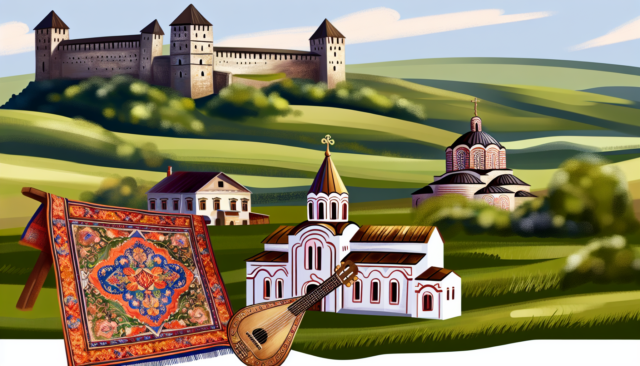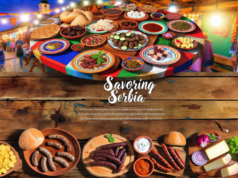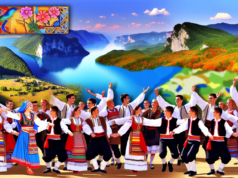
Cultural Delights: Exploring Serbia’s Rich History and Heritage
Nestled in the heart of the Balkans, Serbia is a land steeped in rich history, vibrant culture, and diverse traditions. From its ancient landscapes and medieval castles to its lively festivals and culinary delights, Serbia offers an eclectic mix of experiences that celebrate the country’s heritage. This article aims to explore the cultural treasures that make Serbia a unique destination in Southeast Europe.
A Tapestry of History
Serbia’s history is a complex tapestry woven from various civilizations and influences. From the prehistoric Vinča culture, recognized for its sophisticated settlement patterns and craftsmanship, to the formation of the Serbian state in the 12th century, the country has seen the rise and fall of Empires.
The medieval period gave rise to magnificent monasteries such as the Studenica Monastery, a UNESCO World Heritage site known for its stunning Byzantine frescoes. These monasteries are not merely religious structures, but are also repositories of art and history, reflecting the strong Orthodox Christian legacy in the region. In addition, Serbia’s tumultuous history during the Ottoman Empire shaped various aspects of its culture, creating a fascinating blend of Eastern and Western influences evident in language, architecture, and cuisine.
Architectural Wonders
The architecture of Serbia serves as a chronicle of its past, with structures ranging from Roman ruins to modernist designs. The capital city, Belgrade, is particularly rich in historical architecture. The imposing Kalemegdan Fortress, which overlooks the confluence of the River Sava and Danube, tells tales of battles and settlements dating back to the Roman Empire.
The Palace of Serbia and other governmental buildings showcase neoclassical designs, while neighborhoods like Skadarlija, the bohemian quarter of Belgrade, resonate with traditional Serbian architecture. Each street and building encapsulates stories of resilience and transformation, allowing visitors to walk through time.
Festivals and Traditions
Serbia’s cultural calendar is replete with festivals celebrating folk music, dance, literature, and more. The Guča Trumpet Festival, perhaps the most famous, attracts thousands of visitors each summer. This vibrant festival of brass band music highlights the rich musical traditions of Serbia, characterized by lively performances that fill the air with infectious energy.
Another notable event is the EXIT Festival in Novi Sad, which has gained international acclaim for its eclectic lineup of artists across various genres. It is more than just a music festival; it is a celebration of youth culture, creativity, and freedom, embodying the spirit of modern Serbia while respecting its history.
Traditional celebrations such as Slava, a family saint-day, showcase the deep-rooted values of family, faith, and hospitality. During Slava, families prepare elaborate meals and invite friends and neighbors to join them in a feast, demonstrating the significance of community in Serbian culture.
Culinary Heritage
Serbian cuisine is as diverse as its history, influenced by its various rulers and neighboring countries. The heart of Serbian cooking lies in its use of fresh, local ingredients, making traditional dishes both hearty and flavorful. Classic dishes such as ćevapi (grilled minced meat), sarma (cabbage rolls), and ajvar (pepper and eggplant spread) are staples of the Serbian diet.
Visiting Serbia offers a chance to explore the rich variety of its gastronomy. Food markets burst with seasonal produce, while traditional taverns (kafanas) offer a taste of home-cooked meals paired with local wines and rakija, a potent fruit brandy often enjoyed in social settings. These culinary experiences engage locals and visitors alike, fostering a sense of connection to the land and its traditions.
A Welcoming Spirit
Beyond its historical and cultural assets, what sets Serbia apart is the warmth of its people. Visitors often remark on the kindness and hospitality of Serbians, who take pride in sharing their culture with newcomers. Whether enjoying a meal in a local restaurant, dancing at a folklore event, or simply sharing stories over coffee, the bonds created through personal connections enrich the travel experience.
Conclusion
Serbia may not be the most commonly traversed destination in Europe, but those who venture here are rewarded with a profound appreciation for a nation that honors its past while embracing the future. A journey through Serbia is not merely a trip; it’s an exploration of a country where history, culture, and tradition converge to create a rich and inviting tapestry. From bustling cities to tranquil countryside, Serbia invites you to uncover its cultural delights and discover the soul of the Balkans.













